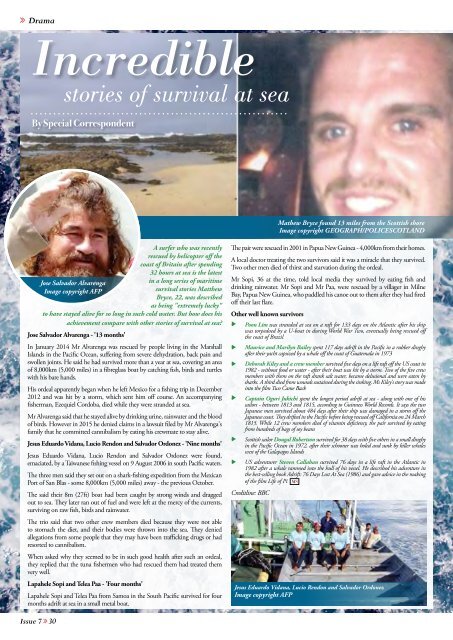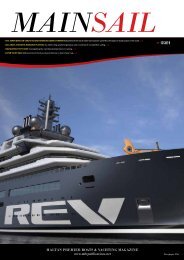Create successful ePaper yourself
Turn your PDF publications into a flip-book with our unique Google optimized e-Paper software.
Drama<br />
Incredible<br />
stories of survival at sea<br />
By Special Correspondent<br />
Mathew Bryce found 13 miles from the Scottish shore<br />
Image copyright GEOGRAPH/POLICESCOTLAND<br />
Jose Salvador Alvarenga<br />
Image copyright AFP<br />
A surfer who was recently<br />
rescued by helicopter off the<br />
coast of Britain after spending<br />
32 hours at sea is the latest<br />
in a long series of maritime<br />
survival stories Matthew<br />
Bryce, 22, was described<br />
as being "extremely lucky"<br />
to have stayed alive for so long in such cold water. But how does his<br />
achievement compare with other stories of survival at sea?<br />
Jose Salvador Alvarenga - '13 months'<br />
In January 2014 Mr Alvarenga was rescued by people living in the Marshall<br />
Islands in the Pacific Ocean, suffering from severe dehydration, back pain and<br />
swollen joints. He said he had survived more than a year at sea, covering an area<br />
of 8,000km (5,000 miles) in a fibreglass boat by catching fish, birds and turtles<br />
with his bare hands.<br />
His ordeal apparently began when he left Mexico for a fishing trip in December<br />
2012 and was hit by a storm, which sent him off course. An accompanying<br />
fisherman, Ezequiel Cordoba, died while they were stranded at sea.<br />
Mr Alvarenga said that he stayed alive by drinking urine, rainwater and the blood<br />
of birds. However in 2015 he denied claims in a lawsuit filed by Mr Alvarenga's<br />
family that he committed cannibalism by eating his crewmate to stay alive.<br />
Jesus Eduardo Vidana, Lucio Rendon and Salvador Ordonez - 'Nine months'<br />
Jesus Eduardo Vidana, Lucio Rendon and Salvador Ordonez were found,<br />
emaciated, by a Taiwanese fishing vessel on 9 August 2006 in south Pacific waters.<br />
The three men said they set out on a shark-fishing expedition from the Mexican<br />
Port of San Blas - some 8,000km (5,000 miles) away - the previous October.<br />
The said their 8m (27ft) boat had been caught by strong winds and dragged<br />
out to sea. They later ran out of fuel and were left at the mercy of the currents,<br />
surviving on raw fish, birds and rainwater.<br />
The trio said that two other crew members died because they were not able<br />
to stomach the diet, and their bodies were thrown into the sea. They denied<br />
allegations from some people that they may have been trafficking drugs or had<br />
resorted to cannibalism.<br />
When asked why they seemed to be in such good health after such an ordeal,<br />
they replied that the tuna fishermen who had rescued them had treated them<br />
very well.<br />
Lapahele Sopi and Telea Paa - 'Four months'<br />
Lapahele Sopi and Telea Paa from Samoa in the South Pacific survived for four<br />
months adrift at sea in a small metal boat.<br />
The pair were rescued in 2001 in Papua New Guinea - 4,000km from their homes.<br />
A local doctor treating the two survivors said it was a miracle that they survived.<br />
Two other men died of thirst and starvation during the ordeal.<br />
Mr Sopi, 36 at the time, told local media they survived by eating fish and<br />
drinking rainwater. Mr Sopi and Mr Paa, were rescued by a villager in Milne<br />
Bay, Papua New Guinea, who paddled his canoe out to them after they had fired<br />
off their last flare.<br />
Other well known survivors<br />
• Poon Lim was stranded at sea on a raft for 133 days on the Atlantic after his ship<br />
was torpedoed by a U-boat in during World War Two, eventually being rescued off<br />
the coast of Brazil<br />
• Maurice and Marilyn Bailey spent 117 days adrift in the Pacific in a rubber dinghy<br />
after their yacht capsized by a whale off the coast of Guatemala in 1973<br />
• Deborah Kiley and a crew member survived five days on a life raft off the US coast in<br />
1982 - without food or water - after their boat was hit by a storm. Two of the five crew<br />
members with them on the raft drank salt water, became delusional and were eaten by<br />
sharks. A third died from wounds sustained during the sinking. Ms Kiley's story was made<br />
into the film Two Came Back<br />
• Captain Oguri Jukichi spent the longest period adrift at sea - along with one of his<br />
sailors - between 1813 and 1815, according to Guinness World Records. It says the two<br />
Japanese men survived about 484 days after their ship was damaged in a storm off the<br />
Japanese coast. They drifted in the Pacific before being rescued off California on 24 March<br />
1815. While 12 crew members died of vitamin deficiency, the pair survived by eating<br />
from hundreds of bags of soy beans<br />
• Scottish sailor Dougal Robertson survived for 38 days with five others in a small dinghy<br />
in the Pacific Ocean in 1972, after their schooner was holed and sunk by killer whales<br />
west of the Galapagos Islands<br />
• US adventurer Steven Callahan survived 76 days in a life raft in the Atlantic in<br />
1982 after a whale rammed into the hull of his vessel. He described his adventure in<br />
the best-selling book Adrift: 76 Days Lost At Sea (1986) and gave advice in the making<br />
of the film Life of Pi MS<br />
Creditline: BBC<br />
Jesus Eduardo Vidana, Lucio Rendon and Salvador Ordonez<br />
Image copyright AFP<br />
Issue 7 >> 30

















